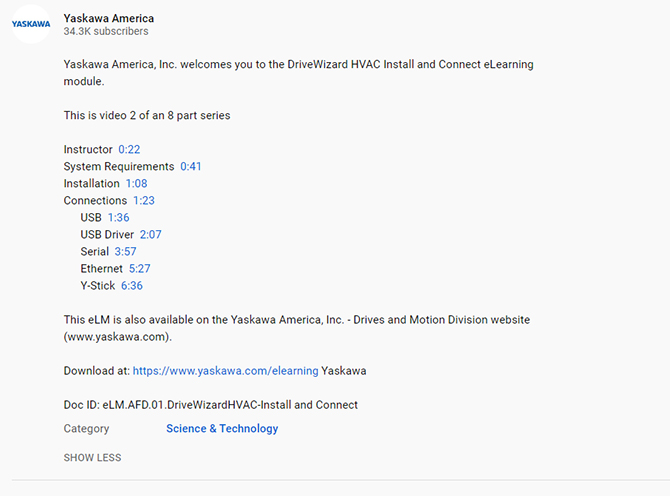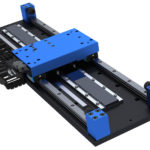
With the current state of the internet and the interconnectivity of devices and equipment, it is in the best interest of any company that wants to optimize the productivity of their associates tasked with technical tasks to take a look at the eLearning available. eLearning offers a wonderful ROI due to its low cost, ease of access, skill based objectives, and ability to customize to each viewer.
 By Paul Avery | Product training engineer at Yaskawa America • Drives and Motion Division
By Paul Avery | Product training engineer at Yaskawa America • Drives and Motion Division
It is a universal truth that training for your employees and staff is a good thing. Finding the time and money to send people off for training … well … not so much. Budgets are tight, people are too busy to be away from their primary responsibilities, and many people don’t like to travel to far away sites no matter how necessary the training might be.
As a technical trainer for variable frequency drives (VFDs) you won’t hear me bad mouthing in-person training as probably the best method of presenting large quantities of mostly new information to groups or individuals. But the reality is that there just isn’t always the time and money available for it.
Enter eLearning. Like all things in modern life, the internet has changed the game when it comes to training people on technical topics. Admit it: The last time you had to repair something around the house you first did a quick search of YouTube to see if there was a video that showed step-by-step how to fix your exact model. The same thinking can be applied to industrial and commercial devices that are just too complex to be intuitive.
Here are some important reasons that justify why eLearning should be part of your employee training curriculum.
Low or no cost: eLearning modules and videos are freely available on the web. Great short and long videos are available either at public sites like YouTube channels, or directly through manufacturer’s websites. Since most web browser can host the video or module, there generally isn’t a cost for special software to view or host the content. And of course, because these are available 24/7/365 on the web, there is no cost for travel, lodging, and meals that are normally a part of onsite training.
Pacing: In every training class, there is always a challenge to create a comfortable learning environment. Part of the challenge is the pacing of the content. It always seems that the information is coming too quickly for some and too slowly for others. Either way, it is easy for the student to lose interest in a class where the pacing is not appropriate for their skill level.
With eLearning the pace of the information is totally controlled by the viewer-student. Beginners can stop the content and review at their leisure and even start over as many times as they would like. More experienced students can skip directly to the part that they are most interested in without sitting through the parts that they already have down. This keeps them engaged and optimizes the time spent on the training.
Many video platforms such as YouTube also let publishing manufacturers to annotate videos with topic timelines to give viewers the ability to jump directly to video portions of interest. Timeline jumping by topic can optimize the student’s time and prevent them clicking away when they are faced with sitting through stuff that doesn’t interest them. Manually forcing them to click around until they find what they want can also lead to frustration.
Universal: Particularly when the eLearning is in the form of YouTube videos, there is a joy in knowing that the devices that can partake of the training are not limited to any one device, like a personal computer, or to any particular platform, like Apple or Android. YouTube videos are available everywhere and the quality of the video is automatically scaled to match the device and internet bandwidth available. Of course, many companies may need to figure out how to allow their personnel access to the eLearning videos without the worry of losing employees to binge watching non-work related or inappropriate content on work hours.
Scale: Unlike in-person training which usually lasts at least a day to multiple days and covers a breadth of topics, eLearning’s specialty is short topic and skills based. Instead of a class on everything, most people want to know about a particular device. An eLearning video will cover a shorter topic and much more skill based — such as How to wire a motor to a VFD. However, many short topic modules can be strung together to create an overall skills-based training certification when testing is included and vetted as part of a course.
Achievements: Speaking of a course style of learning, eLearning can be organized into larger collections and be utilized as part of a Learning Management System or LMS. Students can strive to achieve “badges” or certificates via completing and passing groups of shorter lessons. Just as collections of predetermined classes can lead to an associate or bachelor’s degrees, collections of shorter eLearning tasks can lead to developing a skill. Online lessons can easily be populated with quizzes and tests so that just viewing the lessons is not enough to achieve badges but must be supplemented with passing scores on lesson review quizzes.
Interactive: A subcategory of eLearning is one that couples viewable eLearning modules or videos with online real-time student interaction with actual equipment. Especially usable when teaching skills that require extensive equipment that the student may not have access to but can easily connect to via the internet.
As an example, VFD manufacturers offer software that can be used to customize operation of their VFD but that requires some training to gain mastery of. Students interested in this software can use YouTube to watch demonstrations of the software and then access a VFD connected to the internet to prove their command of the software by completing projects using the same software.
Upon successful completion of the projects the students can earn Professional versions of the customizing software. The student gets something to which the general public doesn’t have access … and the manufacturer gets to know that capable programmers are using their advanced software tools.
You may also like:
Filed Under: Student programs • Technical education, Trends, Fighting COVID-19, Motion Control Tips










